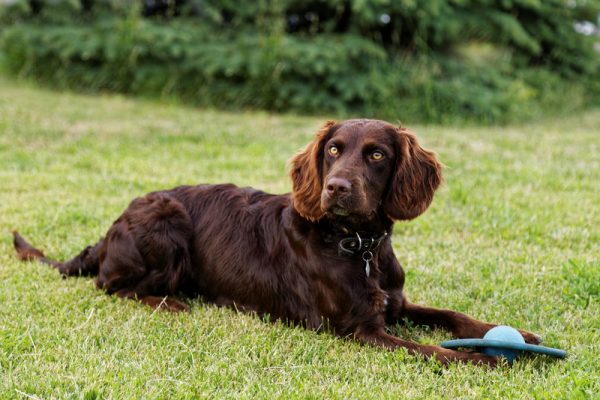
With his wavy hair and spaniel ears, there is little doubt for most experienced sporting breed owners that at first glance, the German Spaniel is probably a flushing dog. In fact, the breed better known as the Wachtelhund (pronounced valk-tell-hund which means “quail dog) is regarded by German hunters as upland bird specialists, but it is actually much more versatile than that. A Wachtelhund can track a 40-hour-old blood trail, hunt larger game, serve as a natural retriever in water, and has even been used to work on wild hogs on an army base in Kansas.
The breed flies under the radar of non-hunting people in Germany, but it’s well known to professional hunters and foresters in that country who are almost exclusively the owners of this breed. In fact, our understanding is that pups aren’t sold to the non-hunting public at all. Buyers must enter their Wachtelhund in a juvenile hunt test before the dogs are 18 months old, and anyone who wants to breed their dog must first get permission from the Verein Deutsche Wachtelhund (the German Wachtelhund Club). As a rule, it is the hunters who are motivated to work with these dogs and pursue the hunt tests; they know that this is a forest dog superb at finding sparse game in challenging environments under harsh conditions. Put another way, the breed is wasted on those who don’t use its talents.
The Wachtelhund’s main job is to rummage in a forest where he naturally hunts in an arc pattern before the hunter. This isn’t a breed that is constantly stuck to the feet of its handler. He is an obsessive scent follower with Bloodhound like persistence. He tends to hunt for about 20 to 40 minutes, then comes back to his person.
Nor is this a pack dog. He is a one-on-one hunting dog who can hold a wounded boar at bay, if need be. The Wachtelhund is basically a flusher who will sometimes flash point, but he is best at going in for the kill.
This is not a quiet dog. In a departure from other spaniels, one of the unique qualities of the Wachtelhund is his tendency to give tongue when trailing game, a handy trait in deep forests and thick brush. Once game is found, a Wachtelhund will be loud and persistent.
Several Wachtelhunde were brought to United States in the late 1960s and early 1970s. The dogs were only bred once or twice and produced a total of 17 dogs. In 1994, another pair of Wachtelhunds were brought to the United States, and our understanding is that they were the first Wachtelhunde to be recognized and registered with the United Kennel Club. Today, it’s thought that there are about 100 of these dogs in North America.
Image by © Konstantin Markov/Dreamstime.com
